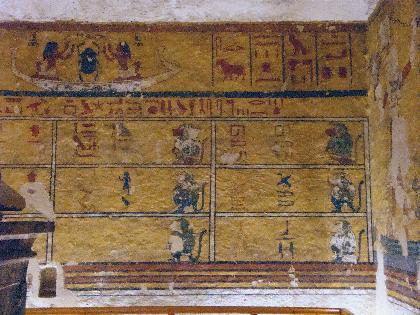Ay is Tutankhamen's successor, who took the throne following the death of the young king, he served at the royal court as a vizier then he ruled the country for a very few years (about 2 years). The Tomb of Ay (WV 23) lies at the end of the West Valley and it was explored in 1816 by Giovanni Belzoni. There is no doubt that the occupant of the tomb was Ay, the successor of Tutankhamen, however some Egyptologists believe that the tomb may originally belonged to one of those kings: Akhenaton, Tutankhamen or Smenkhkare. The plan of the tomb is more similar to the design of royal tombs at Tall al-Amarna than to earlier Dynasty 18 royal tombs. it is similar to the tomb of Tutankhamen (KV 62) to the extent that some scholars believe that both of these tombs were designed by the same artist. The stairs leads to two long wide corridors, an intervening staircase, and the small chamber E. The chamber beyond, burial chamber J, was originally meant to be pillared. Unfortunately, many of the scenes in this tomb deliberately have been damaged, because it belongs to the Amarna period, the visitor easily can notice that from the erased cartouches and faces of the king. WV23 looks like an art gallery than a royal tomb, since the walls of this tomb are skillfully decorated and they are well worth a look.
- The Burial Chamber of the Tomb of Ay
On the rear wall, a representation of the Four Sons of Horus was painted directly above a low gate leading to side chamber J, which is the storeroom for canopic jars. The left wall of the chamber, in the upper register, the goddess Nephthys stands between two solar barks. That on the left carries two standards topped with falcons. On the right, the other carries the nine deities of the Ennead. From right to left, these are: Ra-Harakhty, ِAtum, Shu, Tefnut, Geb, Nut, Osiris, Isis, and Horus. Below, columns of text are from the book of the Dead, dealing with eternal life and the gates in the netherworld. To the right, Ay and his Ka greet Hathor, Nut, and Osiris. On the right wall, the scenes are taken from the first hour of the Imydwat. in the upper register, a scarab beetle, the daytime form of the sun god, comes forth in his sacred bark. Below, baboons express the world's delight at the reappearance of the sun. It's a very unique scene to be found in one of the royal tombs since we used to find it on the walls of the private tombs. Ay and his wife stand in a small reed skiff sailing through a marsh along the edge of the Nile, and the queen reaches out to pull papyri from the water. At right, there was a scene of the king harpooning a hippopotamus, but the wall here has been so badly destroyed. At left, there is a scene showing the king wields a throwing stick and a dozen ducks rise from the marshes, trying to escape.
- The Sarcophagus of The Tomb of King Ay
The granite sarcophagus of the tomb was found broken in the center of the chamber. it was removed to the Cairo museum for restoration, then it was sent back to the tomb in 1990. Upon the box, we can find Scenes from the Book of the Dead. These scenes show the goddesses Neith, serqet, Isis, and Nephthys, and winged solar disc.
